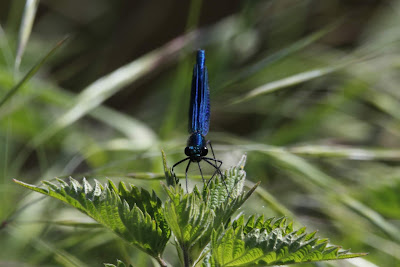With lockdown easing a small amount, the powers that be have now deemed it OK to travel to places for leisure activities. This means I can finally leave the Local Patch, a place I have been visiting everyday for two months, and I was finally able to explore somewhere further afield. So with this inaugural leisure activity day I decided to travel to Pipps Ford, for a mornings birdwatching. This is a good local birding spot, and with few other people there's no need to worry about social distancing and transfer of Covid-19.
River Farm Lock
Part of the site is an active quarry, with another area already worked out, which is now being restored, and there are two small lakes as well, all adding to the mix.
BANDED DEMOISELLE, a kind of damselfly, are common on the river
The footpath splits its way through the quarry, between the worked out area and the active part. The worked out area of the quarry, held decent numbers of COOT with brood of 2 from one pair, with another pair nesting, with other birds lingering. There was also a GREYLAG GOOSE brood of 5, which were paraded about by their wary parents. There were four TUFTED DUCK, and one LITTLE GREBE, the latter usually nest here, so maybe there is a female sitting on eggs somewhere. Five LAPWING were about, tumbling around in the air, seeing off any crows, which is a sign some will have chicks, or are maybe late nesters. A ROE DEER, was present at the back, taking a drink from the quarry, a mammal I see here fairly regularly, I think one lives in the area. In the surrounding rough grassland there are good numbers of SKYLARK, most had stopped singing and were now looking after chicks, often seen carrying food to their hidden nests.
BANDED DEMOISELLE, these insects have newly emerged
The active quarry, which shifts in shape from year to year, was just a deep lake with little mud this year. A LITTLE RINGED PLOVER was present, this is the only site in Suffolk where they nest, there isn't much suitable habitat in the county. There were three TUFTED DUCK and three GADWALL, birds which may stay to nest here. The sand quarry, is a good inland site for SAND MARTINS which nest in the sandy walls that form part of the active quarry. Large numbers of birds hawk over the landscape, dashing here and there as they catch insects in the air. The constant changing in habitat, as the quarry evolves mean the birds have to build out new nesting sites each year, but the birds don't mind, they come back to nest every time.
The martins, the plovers and lapwing are all birds of habitats in transition, they like places that change from year to year. The martins nest in constantly eroding sandy cliffs, whilst plovers naturally nest around rivers, that change from year to year, whilst lapwing favour areas that are newly flooded. In a natural environment, dynamic natural forces create these transitional habitats, and those species would be common. In today's tidy, overly manged countryside they are restricted to a couple of sites such as Pipps Ford.
As soon as the quarry at Pipps Ford becomes exhausted and becomes unprofitable, then the transitional nature of the habitat will end, and once the diggers leave, so will those birds. Even if this place becomes a nature reserve they still won't be able to replicate the quarry habitat those birds need.
Pair of GREYLAGS, River Farm Pit
Having been in lockdown for two months any place other than the Local Patch is going to seem like a birding hotspot. Pipps Ford is probably the best site in Suffolk for the active quarry habitat, and so is good for the species associated with it. Being inland also adds to its importance, as inland Suffolk is lacking in many wetlands. All we need now is for the Suffolk Wildlife Trust to take over management of the site, once quarrying ends, to turn this into a regional hub for wetland birds. I can only hope, but more likely it will be turned into a fishing pit like every other lake in the area.





No comments:
Post a Comment